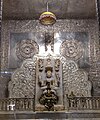Padmavati (Jainism)
| Padmavati | |
|---|---|
 Padmavati, 10th century, Metropolitan Museum of Art | |
| Genealogy | |
| Spouse | Dharanendra |
| Part of a series on |
| Jainism |
|---|
 |
Padmāvatī is the protective goddess or śāsana devī (शासनदेवी) of Pārśvanātha, the twenty-third Jain tīrthāṅkara, complimenting Parshwa yaksha in Swetambara and Dharanendra in digambar the shasan deva.[1] She is a yakshini (attendant goddess) of Parshwanatha.[2]
Jain biography
[edit]There is another pair of souls of a nāga and nāginī who were saved by Parshwanath while being burnt alive in a log of wood by the tapas kamath, and who were subsequently reborn as Indra (Dharanendra in particular) and Padmavati (different from sashan devi) after their death.[3] According to the Jain tradition, Padmavati and her husband Dharanendra protected Lord Parshvanatha when he was harassed by Meghmali.[4][5] After Padmavati rescued Parshvanatha grew subsequently powerful in to yakshi, a powerful tantric deity and surpassed other snake goddess Vairotya.[6]
Legacy
[edit]Worship
[edit]
Goddess Padmavati along with Ambika and Chakreshvari are held as esteemed deities and worshipped by Jains along with tirthankaras.[7][8] Ambika and Padmavati are associated with tantric rituals. Both Padmavati and Dharanendra are revered exclusively as powerful intercessor deities.[1] These tantric rites involves yantra-vidhi, pitha-sthapana and mantra-puja.[9][6] Friday of every week is a particularly popular day to worship the Goddess.[10]
In literature
[edit]- Bhairava-Padmavati-Kalpa written by Mallisena in 12th century is tantric text to worship Padmavati. The text discusses rites connected with Padmavati, namely, stambha, vasya, akarsana, nimitta-jnana, garuda tantra etc.[11]
- Adbhuta-Padmavati-Kalpa is Śvetāmbara text composed by Shri Chandra Suri, 12th century.[11]
- Padmavati-astaka composed by Śvetāmbara scholar Parshvadeva gani is commentary of various tantric rites.[11]
- Padmavati-catusadika composed by Jinaprabha suri.[11]
- Padmavati-Pujanama, Padmavati-strota, Padmavati-sahasra-nama-strota, Rakta-Padmavati-Kalpa are tantric text dedicated to Padmavati.[11]
Iconography
[edit]A snake's hood covers her head, and she sits on a lotus flower. Often a small image of Parshvanatha is placed in her crown. She may be depicted as four-armed, carrying noose and rosary (japa mala), elephant goad, lotus and a fruit.[4] Her mount, or vahana, is the rooster.[12] Yaksha-Yakshi pair sculptures of Padmavati Ambika and Dharanendra are one of the most favoured along with Gomukha-Chakreshwari and Sarvahanabhuti-Ambika.[13]
-
'Mandala of Padmavati', bronze, Walters Art Museum, 11th century
-
Sculpture of Goddess Padmavati in Akkana Basadi, 12th century
-
Sculpture of Padmavati in the Government Museum and Art Gallery, Chandigarh. Chola dynasty, 13th century
-
Goddess Padmavati at Walkeshwar Jain Temple
-
Padmavati at Shri Mahavirji
-
Goddess Padmavati at Hanumantal Bada Jain Mandir, Jabalpur
Main temples
[edit]- Padmakshi Gutta in Warangal, Telangana
- Padmavati temple, Humcha, 7th century temple
See also
[edit]References
[edit]Citation
[edit]- ^ a b Cort 2010, p. 186.
- ^ Cort 1987, pp. 235–255.
- ^ Babb 1996, p. 33.
- ^ a b Jain & Fischer 1978, p. 21.
- ^ Sūri, Raval & Shah 1987, p. 267.
- ^ a b Shah 1987, p. 221.
- ^ Krishna 2014, p. 68.
- ^ Chawdhri 1992, p. 128.
- ^ Tiwari 1989, p. 29.
- ^ Dundas 2002, pp. 213–214.
- ^ a b c d e Shah 1987, p. 277.
- ^ "Jain Goddess Padmavati | India (Gujarat)". The Metropolitan Museum of Art. Retrieved 11 August 2024.
- ^ Tiwari 1989, p. 13.
Source
[edit]- Dundas, Paul (2002) [1992], The Jains (Second ed.), London and New York: Routledge, ISBN 978-0-415-26605-5
- Shah, Umakant P. (1987), Jaina Iconography, Abhinav Publications, ISBN 978-81-7017-208-6
- Jain, Jyotindra; Fischer, Eberhard (1978), Jaina Iconography, Leiden: Brill Publishers, ISBN 978-90-04-05259-8
- Cort, John (2010). Framing the Jina: Narratives of Icons and Idols in Jain History. Oxford University Press. ISBN 9780199739578.
- Babb, Lawrence A. (1996). Absent Lord: Ascetics and Kings in a Jain Ritual Culture. Berkeley, Calif.: University of California Press. ISBN 9780520203242. Retrieved 22 September 2017.
- Tiwari, Dr. Maruti Nandan Prasad (1989). Ambika in Jaina Art and Literature. Bharatiya Jnanpith.
- Krishna, Nanditha (2014). Sacred Plants of India. Penguin UK. ISBN 9789351186915.
- Chawdhri, L. R. (1992). Secrets of Yantra, Mantra and Tantra. Sterling Publishers Pvt. Ltd. ISBN 9781845570224.
- Sūri, Padmasundara; Raval, D. P; Shah, Nagin J (1987). Padmasundarasūriviracita Yadusundaramahākāvya. L. D. Series 105 (in Sanskrit). Ahamadābād: Lālabhāī Dalapatabhāī Bhāratīya Saṃskṛti Vidyāmadira.
- Cort, John (1 January 1987). "Medieval Jaina Goddess Traditions". Numen. 34 (2): 235–255. doi:10.1163/156852787x00047. ISSN 1568-5276.
External links
[edit] Media related to Padmavati (Jainism) at Wikimedia Commons
Media related to Padmavati (Jainism) at Wikimedia Commons









